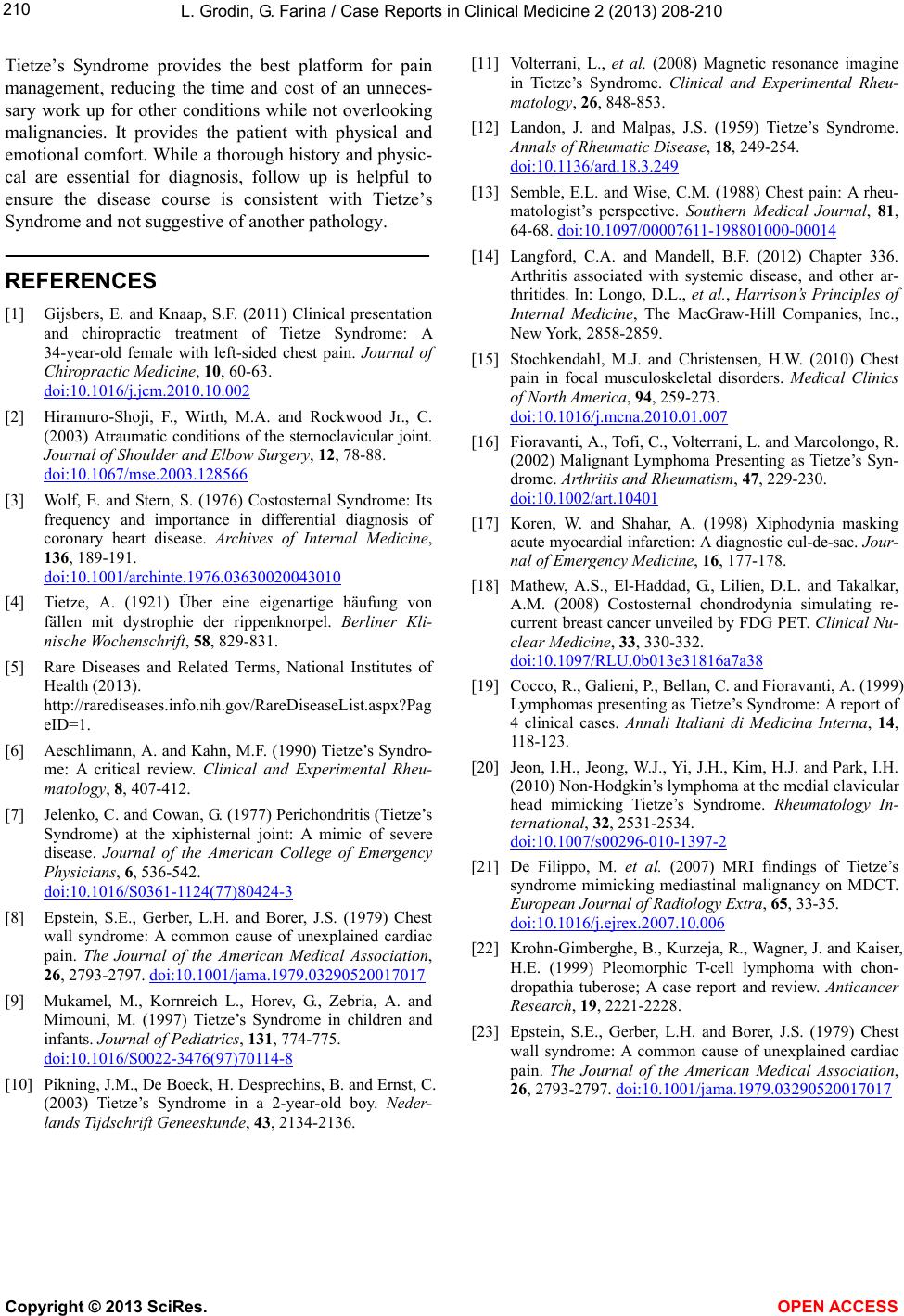
L. Grodin, G. Farina / Case Reports in Clinical Medicin e 2 (2013) 208-210
Copyright © 2013 SciRes. OPEN ACCESS
210
[11] Volterrani, L., et al. (2008) Magnetic resonance imagine
in Tietze’s Syndrome. Clinical and Experimental Rheu-
matology, 26, 848-853.
Tietze’s Syndrome provides the best platform for pain
management, reducing the time and cost of an unneces-
sary work up for other conditions while not overlooking
malignancies. It provides the patient with physical and
emotional comfort. While a thorough history and physic-
cal are essential for diagnosis, follow up is helpful to
ensure the disease course is consistent with Tietze’s
Syndrom e an d not suggestive of another pathology .
[12] Landon, J. and Malpas, J.S. (1959) Tietze’s Syndrome.
Annals of Rheumatic Disease, 18, 249-254.
doi:10.1136/ard.18.3.249
[13] Semble, E.L. and Wise, C.M. (1988) Chest pain: A rheu-
matologist’s perspective. Southern Medical Journal, 81,
64-68. doi:10.1097/00007611-198801000-00014
[14] Langford, C.A. and Mandell, B.F. (2012) Chapter 336.
Arthritis associated with systemic disease, and other ar-
thritides. In: Longo, D.L., et al., Harrison’s Principles of
Internal Medicine, The MacGraw-Hill Companies, Inc.,
New York, 2858 -2859.
REFERENCES
[1] Gijsbers, E. and Knaap, S.F. (2011) Clinical presentation
and chiropractic treatment of Tietze Syndrome: A
34-year-old female with left-sided chest pain. Journal of
Chiropractic Medicine, 10, 60-63.
doi:10.1016/j.jcm.2010.10.002
[15] Stochkendahl, M.J. and Christensen, H.W. (2010) Chest
pain in focal musculoskeletal disorders. Medical Clinics
of North America, 94, 259-273.
doi:10.1016/j.mcna.2010.01.007
[2] Hiramuro-Shoji, F., Wirth, M.A. and Rockwood Jr., C.
(2003) Atraumatic conditions of the sternoclavicular joint.
Journal of Shoulder and Elbow Surgery, 12, 78-88.
doi:10.1067/mse.2003.128566
[16] Fioravanti, A., Tofi, C., Volterrani, L. and Marcolongo, R.
(2002) Malignant Lymphoma Presenting as Tietze’s Syn-
drome. Arthritis and Rheumatism, 47, 229-230.
doi:10.1002/art.10401
[3] Wolf, E. and Stern, S. (1976) Costosternal Syndrome: Its
frequency and importance in differential diagnosis of
coronary heart disease. Archives of Internal Medicine,
136, 189-191.
doi:10.1001/archinte.1976.03630020043010
[17] Koren, W. and Shahar, A. (1998) Xiphodynia masking
acute myocardial infarction: A diagnostic cul-de-sac. Jour-
nal of Emergency Medicine, 16, 177-178.
[18] Mathew, A.S., El-Haddad, G., Lilien, D.L. and Takalkar,
A.M. (2008) Costosternal chondrodynia simulating re-
current breast cancer unveiled by FDG PET. Clinical Nu-
clear Medicine, 33, 330-332.
doi:10.1097/RLU.0b013e31816a7a38
[4] Tietze, A. (1921) Über eine eigenartige häufung von
fällen mit dystrophie der rippenknorpel. Berliner Kli-
nische Woch enschrift, 58, 829-831.
[5] Rare Diseases and Related Terms, National Institutes of
Health (2013).
http://rarediseases.info.nih.gov/RareDiseaseList.aspx?Pag
eID=1.
[19] Cocco, R., Galieni, P., Bellan, C. and Fioravanti, A. (1999)
Ly mphomas presenting as Tietze’s Syndrome: A report of
4 clinical cases. Annali Italiani di Medicina Interna, 14,
118-123.
[6] Aeschlimann, A. and Kahn, M.F. (1990) Tietze’s Syndro-
me: A critical review. Clinical and Experimental Rheu-
matology, 8, 407-412. [20] Jeon, I.H., Jeong, W.J., Yi, J.H., Kim, H.J. and Park, I.H.
(2010) Non-Hodgkin’s lymphoma at the medial clavicular
head mimicking Tietze’s Syndrome. Rheumatology In-
ternational, 32, 2531-2534.
doi:10.1007/s00296-010-1397-2
[7] Jelenko, C. and Cowan, G. (1977) Perichondritis (Tietze’s
Syndrome) at the xiphisternal joint: A mimic of severe
disease. Journal of the American College of Emergency
Physicians, 6, 536-542.
doi:10.1016/S0361-1124(77)80424-3
[21] De Filippo, M. et al. (2007) MRI findings of Tietze’s
syndrome mimicking mediastinal malignancy on MDCT.
European Journal of Radiology Extra, 65, 33-35.
doi:10.1016/j.ejrex.2007.10.006
[8] Epstein, S.E., Gerber, L.H. and Borer, J.S. (1979) Chest
wall syndrome: A common cause of unexplained cardiac
pain. The Journal of the American Medical Association,
26, 2793-2797. doi:10.1001/jama.1979.03290520017017
[22] Krohn-Gimberghe, B., Kurzeja, R., Wagner, J. and Kaiser,
H.E. (1999) Pleomorphic T-cell lymphoma with chon-
dropathia tuberose; A case report and review. Anticancer
Research, 19, 2221-2228.
[9] Mukamel, M., Kornreich L., Horev, G., Zebria, A. and
Mimouni, M. (1997) Tietze’s Syndrome in children and
infants. Journal of Pediatrics, 131, 774-775.
doi:10.1016/S0022-3476(97)70114-8
[23] Epstein, S.E., Gerber, L.H. and Borer, J.S. (1979) Chest
wall syndrome: A common cause of unexplained cardiac
pain. The Journal of the American Medical Association,
26, 2793-2797. doi:10.1001/jama.1979.03290520017017
[10] Pikning, J.M., De Boeck, H. Desprechins, B. and Ernst, C.
(2003) Tietze’s Syndrome in a 2-year-old boy. Neder-
lands Tijdschrift Geneeskunde, 43, 2134-2136.